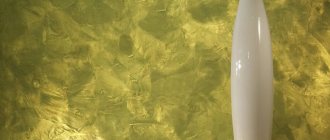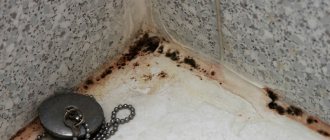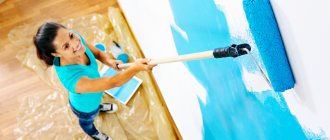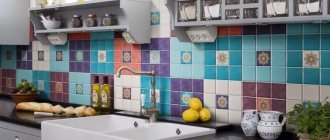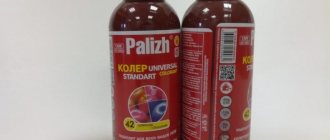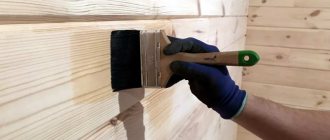Painted walls, just like furniture and home furnishings, require proper care and wet cleaning. But, depending on the coloring composition, it is necessary to take into account certain nuances and recommendations.
Thus, it is best to wipe walls painted with water-based emulsion with a dry soft sponge. But acrylic and silicone compounds are quite resistant to moisture. Therefore, any detergent (with the exception of aggressive chemicals) can be used for washing. How to prepare for this process and how to wash without streaks? How to remove stains and how to test a cleaning product for safety?
Ammonia for oil and alkyd enamel
On such a surface there is a durable and dense film that is resistant not only to moisture and water, but also to mechanical stress. Therefore, such walls can be safely washed, but it is not recommended to use soap, soda or washing powders for this.
An excellent remedy for oil and alkyd enamel is an aqueous solution of ammonia, which can be prepared at the rate of 1 tablespoon per 1 liter of warm water.
The process of washing walls is simple - you need to soak a sponge in a solution of ammonia and use it to rub the stained area.
If ammonia does not help, then you can try fresh potatoes, the tuber of which needs to be grated on a fine grater, after which the gruel is applied to a sponge and rubbed over the dirty area.
Removing greasy stains from a painted wall
Views 2,346
Grease stains on the kitchen wall are, unfortunately, inevitable. Even if you are very careful, something will always happen, or grease will splatter in all directions. In addition, traces of small, dirty hands often remain on the walls. They are very easy to wash off from the tiles, it is worse if the stains appear on the paint. Painting walls is not always the only solution. DOMOVEY will tell you how to remove grease stains from a painted wall using home remedies.
What should you consider before removing grease stains from a painted wall?
This problem most often happens in the kitchen. The situation gets worse when the wall is painted and grease has settled on this surface. Removing grease stains from a painted wall is not impossible, but the consequences of our actions may vary. It all depends on the quality of the paint we used, so in places like the kitchen there is no need to skimp on this. If the product is of poor quality, unfortunately, along with the stain, we can remove the paint. Therefore, kitchen paint must be resistant to washing or cleaning.
In theory, removing grease stains from the wall is not particularly difficult, provided that you wipe them off immediately after staining. Then there will really be no traces left - the final chord will be made by a damp, soft sponge, with which you will collect the remaining food.
However, it should be remembered that washing the walls immediately after painting is not recommended - the drying process sometimes takes even 28 days, so instead of washing off the stain, you can simply wipe off the paint. If you act quickly, the fat molecules will not have time to penetrate the structure, so you will not wash off the paint, and removing stains will be much less troublesome.
However, sometimes spots escape our attention and are simply invisible. After a while, when they dry out, getting rid of them seems bordering on a miracle. Grease soaks into the wall, binds to the paint structure, and is difficult to remove. However, you should not give up, but try one of the methods suggested below.
HOUSEHOLD TIP: If you're not sure the method you choose won't leave a mark, try removing the grease stain in an unseen area first, such as behind a cabinet or refrigerator.
1. Hot water and dishwashing liquid
If you quickly notice dirt, you can try to clean the stain with a regular dishwashing sponge. The method will work more effectively if you soak it in water and dishwashing liquid.
There are many stronger detergents on the market, but the liquid is very effective. After all, it was designed to bind and wash away grease, so it works better, even on painted walls if you're worried about discoloration.
Feel free to apply a lot of product to the wall and make a lot of foam. This will make stains easier to remove, and cleaning with dishwashing liquid is color safe. Nowadays, the vast majority of paints are waterproof and washable, so there should be no residue left after cleaning.
However, it is best to do this carefully. Do not rub, move the sponge vertically from top to bottom with light movements. Then dry the stain with a paper towel and let it dry - there should not be the slightest trace of grease left.
HOME TIP: If you have very hard tap water, use boiled or distilled water for this purpose to avoid unsightly deposits on the surface.
2. Sponge and alcohol
This is also an effective way to deal with fat without any problems. Take a dry sponge and lightly moisten it with alcohol. Then gently wipe away the grease stain.
DOMOVEY recommends: How to clean white kitchen cabinets?
3. Starch or talc
Grease stains on the wall are quite specific - to remove them, you need to apply products that, like water and dishwashing liquid, absorb grease particles. This is why many home methods rely on dry foods to absorb moisture and oil.
Splashes of oil or traces of food residues can be removed with starch. First, press the paper towel firmly against the wall to absorb as much moisture as possible. Then sprinkle the stain with starch or talcum powder. Leave for several hours - bulk products of this type will absorb dirt. After that, all you need to do is wipe off or brush off the powder with a broom. If there is still a small mark on the wall, you can use the dishwashing liquid method.
4. Shaving foam
Grease stains on the wall sometimes need to be removed immediately after they appear. If you don’t have specialized detergents for cleaning walls at home, and dishwashing liquid doesn’t work, you can try this life hack. Stains and drips on the kitchen wall can be treated with shaving foam. Squeeze out a small amount of foam and leave on the stain for 2-3 hours, then rinse with a damp sponge or cloth.
5. Glass cleaning liquid
Another option for getting rid of greasy stains on a painted wall involves spraying glass cleaning liquid. Wait a few minutes for this to work. Wash the wall with warm water. Window glass cleaners also have grease-removing properties, and most are gentle enough not to damage the paintwork. However, beware of alcohol-based products, although they are indeed effective in reducing fat.
6. Melamine sponge
Magic sponges, as they are often called, are great for cleaning any surface. Its use is very simple: you just need to moisten the sponge and you can use it right away. They deal with greasy stains on the wall instantly. Just remember not to rub too hard as you risk destroying the paint.
HOUSEHOLD TIP: It's always worth keeping melamine sponges around the house because they can come in handy when other remedies have failed. If you've never had one, we recommend purchasing one because they're really useful around the house. Moreover, they are not at all expensive and durable. They work well for cleaning everyday dirt as well as stubborn, hard-to-remove stains such as crayon marks on walls or shoe marks on rubber floors. Melamine sponges do not require contact with chemicals to achieve the best results, making them an even more environmentally friendly and cost-effective cleaning solution.
7. Painting over greasy spots on the wall
This radical method should be resorted to if the contaminated area is very large or if home methods and special chemicals are ineffective. When starting this type of work, it is worth considering that painting a greasy stain is not easy. This is where the paint loses its adhesion, so after painting and drying, the stain will still show through the paint. Therefore, first wash the wall as thoroughly as possible and then apply primer. Only after this we cover the wall with new paint.
If stains appear on a white wall, scrape off the dirty layer of paint (if necessary, also the top layer of plaster). Reapply plaster or plaster to the damaged area. Apply special stain paint. Repaint the wall with white paint.
Painting walls is not only a quick way to freshen up a room, but also introduces elements of interior fashion. If the kitchen design does not require strict adherence to color schemes, you can always experiment and paint the stained wall a different color. Fragments in the form of geometric shapes that can be randomly “scattered” on the wall also look interesting.
DOMOVEY recommends: Geometry in interior design
Posting site materials is allowed only if there is an active hyperlink https://domovei.com/
4.3 12 votes
Article rating
Soda for latex paints
Dirt from latex, acrylic and silicone coatings can be removed with almost any non-aggressive detergents. However, the real panacea is baking soda, which in the form of a paste can cope with even severe stains.
To clean more extensive stains, you can use a solution, for the preparation of which you will need:
- 3 l. clean water at room temperature;
- 100 gr. baking soda;
- 50 ml. ammonia.
Important! To protect the skin of your hands, be sure to use rubber gloves!
Using vinegar
A cleaning solution containing vinegar is suitable for most painted walls. White table wine vinegar should be added to the water. You need to take 240 ml of this product in a bucket of warm water. You need to prepare 2 buckets of water. The first will contain a cleaning composition, and the second will contain ordinary clean water. As the water becomes contaminated, it needs to be changed. Finally, rinse the walls with clean water.
Important! To care for painted walls, do not use products containing ethyl alcohol. It is bad for paint and can destroy it in some places.
How to wash without streaks?
To prevent stains from remaining on the walls after washing, you must follow simple rules:
- If the product is new, test it on an inconspicuous area of the wall;
- First apply the products to the sponge/brush and only then to the wall;
- Prepare paper towels, napkins and toilet paper for blotting in advance;
- The process of washing walls always starts from the bottom;
- Any leaks that appear are immediately removed;
- Dirty liquid and foam are not reused.
By following the above recommendations, your walls will always be as good as new, and dirt stains will no longer cause headaches. You should also not forget about regular cleaning, because preventing a problem is easier than solving it.
Preparing to wash
Before washing, make sure that the wet coating dries quickly. This is possible if the house is warm and there is no excessive humidity. Otherwise, streaks and sometimes even mold may occur, which is very difficult to get rid of.
It is also recommended to carry out preparatory work before washing:
- Prepare the room . First of all, you need to remove photographs, paintings and posters hanging on the walls. Decorative items also need to be removed. Next, mark all the loose nails and hooks (so as not to injure your palms during the washing process). To do this, you can attach scraps of bright fabric to them (on nails). Now that all the walls are free of obstacles, you need to move the furniture to the center of the room (so that you can move freely).
- Protect the floor from moisture . To do this, you need to spread thick fabric or film along the baseboards. Furniture is also covered in the same way (but it is best to use film).
- Remove dust from the coating . Before washing, carry out dry cleaning, removing dust from the walls and ceiling skirting boards. The easiest way is to use a vacuum cleaner turned on at low power.
Important! It is recommended to carry out wet cleaning as the walls become dirty, but it is better to do this at least twice a year - in autumn and spring. In the first case, dust and dirt could enter the house through open windows; in the second, during the heating season, dust was carried with air currents throughout the house, firmly sticking to the walls.




